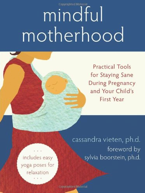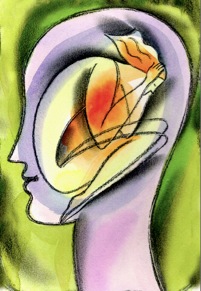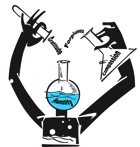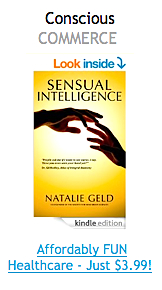The Whole Enchilada & The ‘Other’ Hard Problem of Consciousness
WhyAreWeWhispering.com

what does consciousness offer?
“Consciousness practices offer richness, juiciness, depth, meaning, purpose, awe, wonder, joy, pain -- all of it.
The whole enchilada.”
Cassandra Vieten, Ph.D. is extraordinary – a licensed clinical psychologist, director of research at the Institute of Noetic Sciences, associate scientist at the Mind Body Medicine Research Group at California Pacific Medical Center Research Institute in San Francisco, CA, co-president of the Institute for Spirituality and Psychology, an author, avid soccer player, and a mom. Say that three times fast.

Cassi’s research on mindfulness-based approaches to dealing with addictions, mood disorders, and for stress reduction during pregnancy and early motherhood have been funded by the National Institutes of Health, the State of California, and several private foundations. We’re talking about the beauty, benefits and the hard problem of consciousness practices she faces every day with her clients.
Meaning, juiciness, awe... you’re describing our full, vivid potential as human beings. Why do so many people tune out instead and turn to external fixes, drugs and alcohol. Is there a catch?
“Everyone is in such a high state of agitation and stress. The way we live, the way we hurdle down the freeways in our little metal boxes, it makes sense that everybody is scaffolding their lives. Consciousness actually doesn’t offer the kind of numbness or contented pleasure that most people are seeking. Alcohol, cigarettes they work, they work really well. They work really fast, and they’re really cheap, really easy. The only reason everybody wouldn’t be using them is because they kill you. They cause a lot of suffering. It’s hard to find something that matches up against how easy it is for someone to feel terrible and then to smoke a cigarette and feel fine in 3 seconds. They feel fine, and that is powerful.
src="http://pagead2.googlesyndication.com/pagead/show_ads.js">
Unless you intentionally unplug and spend time in silence or in nature, there is rarely a moment where you’re not in all that chaos. Without awareness, people have got to build a scaffold -- here’s my caffeine, my TV, here’s all the things I have to do to keep this completely imbalanced, insane way of living -- moving forward.”
Right, and consciousness transformation develops over time. How, then, do you approach mindfulness in your practice?
“I had to get realistic. This isn’t about saying “Hey, I have something that can replace your cigarette. If you learn this mindfulness thing it’s going to kind of make you feel ___” -- it’s bullshit. It’s actually not ever going to make you feel the same way as does the ease and passivity of smoking a cigarette and to instantly, physiologically experience a feeling of all is well. Nothing is going to combat that.
You tell that to people and they are like “Great, I would rather watch TV.” It’s hard to find something that can break the spell.”

“When someone gets to his or her breaking point -- when they feel “this is actually not fun at all, I am not going to see my kids grow up. I’m coughing, I smell terrible, and this pain I feel outweighs the reward. I will do almost anything to find a new way,” they reach out for help.
But even then, I tell them the good news/bad news is we’re never going to be able to give you anything that feels as good as a cigarette after your craving. There is nothing wrong with you. You’re absolutely hardwired for this, that’s why they are so incredibly popular.”
I’ll bet you could hear a pin drop… what’s their reaction?
“What’s so amazing is they are actually relieved! I hear, “Thank you for saying that.” The truth takes away the shame.
And once they do get into new ways of cultivating their consciousness,
they are like “Wow, okay, this is peace, this is joy. This is beauty.”
src="http://pagead2.googlesyndication.com/pagead/show_ads.js">
Do you find it challenging to discuss consciousness and mindful awareness?
“Yeah, it’s really hard to talk to people about opening their consciousness. It’s a tough road just motivating others to sit on a cushion and watch their thoughts. Some have a powerful intention either through intense suffering or through undeniable, blow out glimpses of awareness. And the landmarks vary. If you’re lucky, you get a few, big lightening bulb moments that sustain you through your spiritual journey. Most people don’t even get that. They get some nice moments and it deepens gradually until they experience the “Oh my God, everything I have ever been looking for is right here in my awareness like you said, in this moment,” moment.
But that takes a while. So I wonder just how do we reach somebody who is not at that deep bottom of suffering or who’s had an a-ha moment to accelerate that inquiry process?”
Right, because so many people consider consciousness transformation as woo-woo, out of their reach or in the domain of Buddhists and spiritual seekers . You don’t have to forgo your body for a pillow, and leave your condo and your BMW behind in order to evolve.

“Well, you know what’s really interesting about that work, although we interviewed all these people, I think sex was probably mentioned 3 or 4 times. Now, granted we did not ask the question.
One of the guys we interviewed was hilarious, he said, ”How can you ask these 20 questions and not ask about sex?”
Sex is most people’s portal to the time when they feel the most sacred, the most connected, the most holy. For the everyday individual sexual intimacy is probably the one place where they ever experience dissolution of self or a true kind of spiritual experience that is completely immaterial, unexplainable and distinctly embodied. And yeah, we didn’t even ask.”
What did you discover from not asking about sexuality?

It resonates for them with a sense of Wow. Okay, so there is something there.”
Why do you think sex is overlooked regarding consciousness?
“Sexuality for most of us, even people who are evolving spiritually, is a part that remains really separate; very un-integrated. Aside from Tantric practices, it’s taboo even in the deepest spirituality. How can that be… that one piece of who we’re being is somehow not allowed into the conversation? I actually feel we haven’t even begun to figure out how consciousness evolves in the context of sexuality. There are such exemplary extremes to follow... you either have the celibate master who decides this area is so fraught with danger and adopts a ‘forget the whole entire thing’ approach, or you have the charismatic master who is having sex with all the students.”
And when we dismiss the context of our sexuality, our energy gridlocks. It’s prohibitive to our well being; our ability to communicate effectively and transform.
“Yes, and imagine the training we’re not getting. We are just now starting to think about training kids in emotional intelligence - to actually teach kids how to talk to each other. Communication is challenging, as we all find out when we grow up and work and are married. What do we get in terms of our training around sexuality? We get the one movie or the ridiculous ‘birds and the bees’ talk. The most training we get about sexuality is through the media.”

“Cultivating awareness is a wonderful foundation for great parenting. Mindful awareness is a skill that can be learned, like playing the piano or learning a new language, and as such it takes practice. There are lots of opportunities now to learn mindfulness -- at a local meditation center, through taking a mindfulness-based stress reduction class, and increasingly mindful parenting classes are popping up everywhere.
The focus here is on being aware of your experiences as parents as they arise. Meeting them as they are, learning to center your attention in the present-moment -- on what actually is happening right now, rather than your stories about it, or what it means.

Riding the waves of life…
“Yes, mindfulness is about learning to approach all of your experiences, as much as possible with openness, curiosity, and compassion. It's about learning to ride the waves rather than resisting them and getting battered about in the process.”
~~~
She is the author of Mindful Motherhood: Practical Tools for Staying Sane During Pregnancy and Your Child's First Year (New Harbinger Publications/ Noetic Books, 2009). In addition, she is coauthor, along with Marilyn Schlitz and Tina Amorok, of Living Deeply: The Art and Science of Transformation in Everyday Life (New Harbinger Publications/ Noetic Books, 2008).
Her website is http://mindfulmotherhood.org.
Taking in the Good

Much as your body is built from the foods you eat, your mind is built from the experiences you have.
The flow of experience gradually sculpts your brain, thus shaping your mind. Some of the results can be explicitly recalled: This is what I did last summer; that is how I felt when I was in love. But most of them remain forever unconscious. This is called implicit memory, and it helps form your expectations, models of relationships, emotional tendencies, and general outlook. Implicit memory establishes the interior landscape of your mind—what it feels like to be you—based on the slowly accumulating residues of lived experience.

Sure, negative experiences do have benefits: Loss opens the heart, remorse provides a moral compass, anxiety alerts you to threats, and anger spotlights wrongs that should be righted. But do you really think you're not having enough negative experiences? Emotional pain with no benefit to yourself or others is pointless suffering. And pain today breeds more pain tomorrow. For instance, according to research by psychiatrist Vladimir Maletic, even a single episode of major depression can reshape circuits of the brain to make future episodes more likely.
src="http://pagead2.googlesyndication.com/pagead/show_ads.js">
The remedy is not to suppress negative experiences; when they happen, they happen. Rather, it is to foster positive experiences—and in particular, to take them in so they become a permanent part of you. Here's how, in three steps.
1. Turn Positive Facts into Positive Experiences
Good things keep happening all around us, but much of the time we don't notice them; even when we do, we hardly feel them. Someone is nice to you, you see an admirable quality in yourself, a flower is blooming, you finish a difficult project—and it all just rolls by. Instead, actively look for good news, particularly the little stuff of daily life: the faces of children, the smell of an orange, a memory from a happy vacation, a minor success at work, and so on. Whatever positive facts you find, bring a mindful awareness to them—open up to them and let them affect you.
2. Savor the Experience
Make positive experiences last by staying with them for 5, 10, even 20 seconds; don't let your attention skitter off to something else. Loyola University psychologist Fred Bryant has shown that savoring positive experiences intensifies our positive response to them. And research by Marc Lewis at the University of Toronto has found that the longer something is held in awareness and the more emotionally stimulating it is, the more neurons that fire and thus wire together, and the stronger the trace of it becomes in our memory.

You can also intensify an experience by deliberately enriching it. For example, if you are savoring a relationship experience, you could call up other feelings of being loved by others, which will help stimulate oxytocin—the “bonding hormone”—and thus deepen your sense of connection. Or you could strengthen your feelings of satisfaction after completing a demanding project by thinking about some of the challenges you had to overcome.
src="http://pagead2.googlesyndication.com/pagead/show_ads.js">
3. Let the Experience Sink In
Finally, imagine or feel that the experience is entering deeply into your mind and body, like the sun's warmth into a T-shirt, water into a sponge, or a jewel placed in a treasure chest in your heart. Keep relaxing your body and absorbing the emotions, sensations, and thoughts of the experience.
Healing Pain
Positive experiences can also be used to soothe, balance, and even replace negative ones. When two things are held in mind at the same time, they start to connect with each other. That's one reason why talking about hard things with someone who's supportive can be so healing: painful feelings and memories get infused with the comfort, encouragement, and closeness you experience with the other person. These mental minglings draw on the neural machinery of memory. When a memory—whether implicit or explicit—is made, only its key features are stored, not every single detail. Otherwise, your brain would become so crowded that it wouldn't have space to learn anything new. For example, remember an experience, even a recent one, and notice how schematic your recollection is, with the main features sketched in but many details left out.When your brain retrieves a memory, it does not do it like a computer does, which calls up a complete record of what's on its hard drive. Your brain rebuilds implicit and explicit memories from their key features, drawing on its simulating capacities to fill in missing details. While this is more work, it's also a more efficient use of neural real estate—this way, complete records don't need to be stored. And your brain is so fast that you don't notice the regeneration of each memory.
This rebuilding process gives you the opportunity, right down in the micro-circuitry of your brain, to gradually shift the emotional shadings of your interior landscape.

The next time the memory is activated, it will tend to bring those associations with it. Thus, if you repeatedly bring to mind negative feelings and thoughts while a memory is active, then that memory will be increasingly shaded in a negative direction.
For example, recalling an old failure while simultaneously lambasting yourself will make that failure seem increasingly awful. On the other hand, if you call up positive emotions and perspectives while an implicit or explicit memory is active, these wholesome influences will slowly be woven into the fabric of that memory.
Why It's Good to Take in the Good.
Given the negativity bias of the brain, it takes an active effort to internalize positive experiences and heal negative ones.When you tilt toward what's positive, you're actually righting a neurological imbalance. And you're giving yourself today the caring and encouragement you should have received as a child, but perhaps didn't get in full measure.
Focusing on what is wholesome, and then taking it in naturally, increases the positive emotions flowing through your mind each day. Emotions have global effects since they organize the brain as a whole. Consequently, as research by University of North Carolina psychologist Barbara Fredrickson has shown, positive emotions don't just feel good in the moment; over time, they produce far-reaching benefits, including a stronger immune system and a cardiovascular system that is less reactive to stress. Fredrickson has also found other long-term benefits of positive emotions: They lift your mood; increase optimism, resilience, and resourcefulness; and help counteract the effects of painful experiences, including trauma. It's a positive cycle: Good feelings today increase the likelihood of good feelings tomorrow.

Taking in the good is not about putting a happy shiny face on everything, nor is it about turning away from the hard things in life. It's about nourishing inner well-being, contentment, and peace—refuges to which you can always return.

Rick Hanson, Ph.D., is a neuropsychologist, author, and teacher working at the intersection of psychology, neurology, and Buddhism. This essay, originally published in Greater Good Magazine, is adapted from his latest book (with Rick Mendius, M.D., Foreword by Daniel Siegel, M.D., Preface by Jack Kornfield, Ph.D.)
Dr. Hanson shares his unique blend of science and wisdom in his free newsletter “Just One Thing” ~ a small thing repeated each day, adds up over time to produce big results.
Running Up That Hill...
By Natalie Geld
WhyAreWeWhispering.comRather than great highs and incredible lows, aim for balance.

Limby and lean, with a smile as broad as her 10 acres, Stephanie shares the very same techniques that successfully rode her through the waves of her divorce.
Natalie: What are Bio Emotional Methods?
“Bio Emotional Methods are tools to gain clarity in every moment for stress and emotional distress. I’ve found that through visualization, aligned body movement - and the release of physical, mental and emotional energy - we can experience relief from stress and pressure.”
Natalie: What are the benefits?
“Instead of waiting for a 'big bang' external change, Bio Emotional Methods allow you to truly build - and rebuild - from within. By using our mind~body connections in a practical way, we create emotional strength and comfort through simple yet powerful changes of state.”
src="http://pagead2.googlesyndication.com/pagead/show_ads.js">
Natalie: Often our thoughts seem to run rampant, feel beyond our control, and it’s almost impossible to keep up let alone make changes. How does it work?
“Your mind is a very logical and practical system. In the middle of runaway thoughts and sleepless nights, making the leap to 'fly with eagles' or to 'be Zen now' is just too far a jump. So, the first step is to get to neutral, where you can begin to see options.
For example, if your car were backsliding down a hill, you'd get yourself safely stopped and give your wheels some traction before you started up again. Same idea – get your feet on the ground, find your center and be aware of your true self to take that next step forward.”
Natalie: What is EFT? Emotional Freedom Technique is compelling in title alone –
"EFT is a very interesting technique based on the meridian energy systems of Chinese medicine. What's beautiful about EFT is that you may not have to fully excavate in order to expose what the particular issue is connected to, sometimes EFT can simply release that pattern.

In the physical realm, sometimes the body just wants to have a conversation, the body is holding or tightening and when you start to put words to it, your body can release, it can let go.”
Natalie: What do you mean by - our body wants to have a conversation?
“Well, I will give you a personal example. I had pain on the right side of my jaw. So I went to my dentist and asked him about it. He said, “Well, look at your teeth, you’re grinding them, you’re biting down.” I said, “I don’t ever grind my teeth and bite down, what are you talking about?”
Later on that weekend, I’m driving in traffic and I realize that not only am I biting down, but I am biting down as hard as I freaking can only on that right side of my jaw. I mean painfully clenching and I’d never noticed that before. So I did what he suggested to correct the issue dentally, but there was always residual pain and I would wake up in the morning and have an aching feeling.
I initiated into self-hypnosis and simply asked, “What is it? What do you want to say?”
Well, let me tell you, the amount of expletives that poured out of my mouth, I mean no sailor could match up! It was amazing to me to hear the honest things I had wanted to say to someone about feeling emotionally devastated, that is what I had been holding. Those feelings are what my jaw muscles were closing down on.
src="http://pagead2.googlesyndication.com/pagead/show_ads.js">
From that point on, those muscles let go as if to say, “Okay, good thank you, you heard me.” It creeps back in once in a while, and I repeat the process...you have to become vigilant about your inner communication, that inner voice, and how the body is expressing or subverting it.”
Use your body to affect the mind or your mind to affect the body, either way – get the conversation started.
Natalie: How does this relate to our sexual lives?
“Most of us walk around not attending to our whole body all day, we tune it out to keep going and then expect to feel a load of sensations for sex. Just not going to happen.”
Natalie: How can we evolve these patterns?

1. Add some level of consciousness; look at yourself from a more nurturing, helpful perspective.
2. Start to notice what happens throughout the day and reshape the negative.
3. Open a bio-emotional conversation in any way possible – breathe, do a little dance, twist and stretch; really listen to the words attached to what you feel - so your mind and body can express those feelings and move on to some good stuff.
We deserve some good stuff.”
Amrita, Our Divine Nectar
WhyAreWeWhispering.com
Amrita is liquid energy.
Anyone can “ejaculate,” or “squirt,” but the goddess in women releases her amrita. The stories that come from ancient Tantra and the holy books of several thousand years past support this, along with the vast subject of sacred sexuality, of which I am a longtime teacher and practitioner. The name in Sanscrit for the female ejaculate is “amrita,” which means “divine nectar.” For this reason I refer to this experience, which I only first heard of twenty years ago in my early forties, as “releasing amrita.”
As a female, I embody the divine, and I clearly honor amrita as a divine expression of the feminine. Videos that purport to show how females can ejaculate are a turn-off to me. Please, those of you with the refinement to keep the sacred intact, remember, there is power in language! Join with me in this little game of consciousness as I describe to you the majestic connection I feel to spirit, to myself, to my partner, and to Life while releasing my amrita.

In the Western world there is a tendency to reduce profound spiritual experience to scientific explanation. The true nature of these sacred waters is more metaphysical than physical. It often feels as though the “energy” of amrita is being released, with no liquid content.
How could this be proven or explained to the scientist in the lab?
There is a commonly held belief that something other than God must be responsible for this potentially profound experience of pleasure - cups of warm clear liquid gushing or spraying out of the female’s genital area (specifically her urinary opening), or meatus. Can we allow that the Goddess herself might take great joy in riding the waves of pleasure, which often accompany a release of amrita? In my experience as a goddess of conscious lovemaking, the words that escape my lips during high states of arousal and orgasm are “Oh my God! Oh my God!” Yet when my amrita flows I experience the most profound connection to the Feminine. I often hear myself exclaiming as I’m flowing, “Thank you Goddess, Thank you, Mother, Thank you Spirit, Thank you, Thank you, Thank you...”
I have taught and exhibited for many women how this feels and looks for me (see the DVD “Secrets of Female Sexual Ecstasy”). This teaching gives people something to emulate, as the partner involved can also ride this huge wave of bliss and help carry the woman further into the fullness of the experience.
Every woman experiences her sexual response somewhat differently, so each must find her own expression in these times of surrender. This release may not feel typically orgasmic. It can go unnoticed by some. The awareness and experience of amrita depends on the level of a woman’s awakened sensitivity to her body.
How do we allow the sacred to enter into this experience? It’s a flip of the switch (of consciousness, that is!). The energy is transmittable. Much depends on a woman’s openness, sense of safety, and, often, spiritual connection to herself or her partner or close friend. I have seen women start the flow of amrita simply by being in the company of another woman releasing. I have experienced holding the hand of a dear friend while I was receiving sacred spot massage, and as my amrita flowed, hers released with such a force it splashed the wall eight feet from the bed!

We use our power of intention to imprint our amrita. This requires creative visualization, a focused mind, and deep, slow breathing. It is by this “knowing” that our natural body fluids become a “medicine” for healing and high magic. Thus, a woman accesses her own spiritual priestess to emerge during this pleasurable event.
Much more is taught about this phenomenon in our bodies in the Divine Feminine Mystery School to help further understanding and deepen people’s experience of it.

Your body is your laboratory, and you, as a woman, have the opportunity to claim your potential and your birthright as a divine mystery.
Caroline Muir, Founder of Divine Feminine
Founder of the Divine Feminine - Awakened Masculine Institute, Caroline is celebrated
as mother of the modern sacred-feminine movement. Her book, Tantra: The Art of Conscious Loving, co-written w/ Charles Muir, & their seminars have inspired over 100,000 readers & 25,000 students.http://www.divine-feminine.com
Sex is Natural - Not Sinful
Living Green from the Inside Out – Recycle your Sexual Energy
Mantak Chia - A Modern Taoist Masterby Christopher Larthe

He was born in Bangkok to Chinese parents in 1944. His father was a Baptist minister, the first break in many generations of Taoist Healers. In a land of Buddhism, with strong Hindu and animist influences, Mantak Chia was brought up as a Christian. After twenty years in the West, he now lives and works at the Tao Garden, the home and healing meditation centre he has created in Northern Thailand.
In this interview for Positive Health magazine, Mantak Chia talks to Christopher Larthe about healing and magic, sex and religion, recycling sexual energy, and immortality.
CL: You taught first in your home city of Bangkok and then in the Chinese community of New York. Your main work was healing, but it was the sexual practices that caught the attention of your Western students. These secret arts were originally taught to enable an Emperor to enjoy his harem of wives and concubines without depleting his energies. You were brought up a Christian. Did you not feel a conflict with the Christian ideas of sin?
MC: No conflict, for sexual practices are healing practices, healing the self, healing relationships. It is only sin if you see it as sin.
Sex is natural, not sinful.
The human being has a powerful sex drive – and you cannot keep ping-pong balls under water. Sometime, somewhere, they pop back up, maybe as disease, maybe as emotional problems, causing energy blockages, leading to illness.
CL: Are you saying we should repress nothing, have sex whenever and wherever, with whoever?
MC: I say sex is your servant, not your master. Who am I to decide where and when, or who you do it with? This is between you and your conscience. I teach how to control and harness the sexual energy, energy powerful enough for a man to repopulate a continent with a single ejaculation. And every woman is born with enough eggs to generate hundreds of lives. Without reproduction all that power is wasted.
If we are not using the hormones and nutrients of sexual activity to start a new life we can recycle it to make our own life longer, healthier, more enjoyable.
Not repressing, recycling!
CL: And the moral aspect?
MC: All the churches make the morals, but they all say different things. Some religions say sex with corpses is a sacred path to enlightenment, with others you may have several wives at once, while in others you go to hell for impure thought.
What is impure thought? Every man secretly imagines being Emperor, having many women, even monks and priests, even saints – Saint Augustine said "Lord give me chastity, but please, not just yet."
Some churches try to make us feel guilty for thinking natural thoughts. Yet these urges make our human species so successful, so strong, survive so many generations. Imagine an enlightened being descending to earth now and telling us it is sinful to move our bowels. We'd all go pop! We cannot help moving bowels it is a natural function. So is sex. In the Tao we say: no right or wrong, no good or bad, just recycling the energy.
CL: Do you still consider yourself a Christian?
MC: I do. These are not religious practices and you don't have to convert! You can be Hindu, Jewish, Buddhist, Muslim and still enjoy the benefits in the framework of your own belief system, if you have one. I am Christian, but don't belong to any church. I may start one here in the Tao Garden – we already married three couples. No, the churches teach about it being bad to do this, bad to do that.
We don't have to be taught what's bad: it comes naturally. Or doing what comes naturally – they call it bad! The Western God is dominant male, very yang, enforcing law with fear of punishment, burn in hell. Society reflects this, with laws enforced by violence. Now there is imbalance between the yang of justice and the yin of compassion.
True religion is about love and compassion.

Mantak Chia with Christopher Larthe
CL: What about the balance of the sexes? You have written a best seller, MultiOrgasmic Man. What about multiorgasmic woman?
MC: Woman naturally is multiorgasmic, and one of my earliest books was about cultivating female sexual energy. Woman is yin. Yang and yin cannot exist without each other, so it is better if they are in harmony. Taoist practice is to promote harmony, because when the man lets go of semen, he is finished, but the woman is ready for more.
When both are in tune, they have increased vigor, improved stamina, enhanced sensation, unlimited whole-body orgasms. Ideal is the multiorgasmic couple. The sexual practices are self-healing for couples.
CL: Conserving energy by seminal retention is an exclusively male practice. How does a woman obtain the benefits of health and longevity?
MC: Woman does not normally lose energy through orgasm, but through menstruation and childbirth. Taoist practices for women recycle menstrual energy, with the same benefits, of long life, good health and painless menstruation as well. But even for man, seminal retention by itself is not enough; non-ejaculatory orgasm without opening the Microcosmic Orbit leads to blockages in the sexual centre, sometimes with aching, congestion, wet dreams, headaches.
Both man and woman must redirect energy through the Microcosmic Orbit, what the classics call the Small Heavenly Cycle. As above, so below – within each one of us is also a small universe, a small cosmos, yin and yang flowing together. In the act of sex, the moment of orgasm, yin and yang unite and the two heavenly cycles become one.
[Excerpted from interview originally published in Positive Health issue 42.]
Taoist practitioner and Tantric scholar, Christopher Larthe is a direct student of Mantak Chia, a certified instructor of the Healing Tao and senior teacher of Chi Nei Tsang. He has been involved in healing meditation since 1972, and founded the Zen School of Shiatsu, the London Healing Tao Centre, and Chi Nei Tsang Institute.
Mantak Chia’s Website
A Few Must Read Selections from Mantak Chia’s Dynamic Book List:
The Multi-Orgasmic Man: Sexual Secrets Every Man Should Know
The Multi-Orgasmic Woman: Discover Your Full Desire, Pleasure, and Vitality
The Multi-Orgasmic Couple: Sexual Secrets Every Couple Should Know
Healing Love Thru the Tao: Cultivating Female Sexual Energy
Chi Nei Tsang: Chi Massage for the Vital Organs
Books at Amazon
Books at Google







